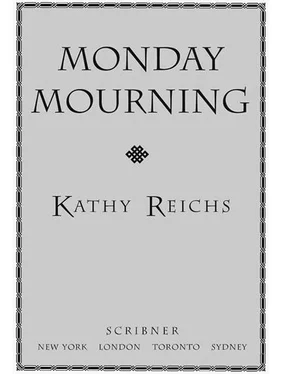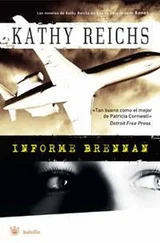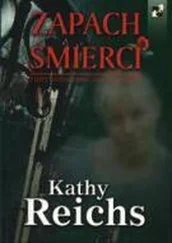Kathy Reichs - Monday Mourning
Здесь есть возможность читать онлайн «Kathy Reichs - Monday Mourning» весь текст электронной книги совершенно бесплатно (целиком полную версию без сокращений). В некоторых случаях можно слушать аудио, скачать через торрент в формате fb2 и присутствует краткое содержание. Жанр: Старинная литература, на английском языке. Описание произведения, (предисловие) а так же отзывы посетителей доступны на портале библиотеки ЛибКат.
- Название:Monday Mourning
- Автор:
- Жанр:
- Год:неизвестен
- ISBN:нет данных
- Рейтинг книги:4 / 5. Голосов: 1
-
Избранное:Добавить в избранное
- Отзывы:
-
Ваша оценка:
- 80
- 1
- 2
- 3
- 4
- 5
Monday Mourning: краткое содержание, описание и аннотация
Предлагаем к чтению аннотацию, описание, краткое содержание или предисловие (зависит от того, что написал сам автор книги «Monday Mourning»). Если вы не нашли необходимую информацию о книге — напишите в комментариях, мы постараемся отыскать её.
Monday Mourning — читать онлайн бесплатно полную книгу (весь текст) целиком
Ниже представлен текст книги, разбитый по страницам. Система сохранения места последней прочитанной страницы, позволяет с удобством читать онлайн бесплатно книгу «Monday Mourning», без необходимости каждый раз заново искать на чём Вы остановились. Поставьте закладку, и сможете в любой момент перейти на страницу, на которой закончили чтение.
Интервал:
Закладка:
“Yeah, she is.” Ryan chuckled the chuckle men use when sharing a joke about women.
Paranoia roared. She is what ? Which she?
Forget it, Brennan. Focus on the case. Keep your energy pointed there.
I pictured the bones in their anonymous cellar graves, Menard buying and selling above in his shop. Electronics stolen for a drug hit. Family heirlooms tendered with regret.
I pictured Menard in Vermont, hoeing peas and potatoes. Menard in California, studying Struever, Binford, Buikstra, Fagan.
An ill-defined thought tried to get my attention.
Chico.
“—got it right here.” Ryan rotated the napkin to read Menard’s address.
Chico is in north-central California. I know that. So why the heads-up from my hindbrain?
That wasn’t it. There was something more. What?
“Will do,” Ryan said.
Charbonneau said something.
“Yeah. Squeeze the squirrel a little. See how he reacts.”
Ryan clicked off and handed me my phone.
“You up for a little chat with this guy?”
“Menard?”
Ryan nodded.
“Definitely.”
The hindbrain thought seemed to relax slightly.
As Ryan and I left the restaurant we had no idea we were being watched.
26
THE MAP OF MONTREAL MAKES ME THINK OF A FOOT, WITH Dorval Airport and the west island suburbs forming the ankle, the toes pointing east, and the heel dropping down into the Fleuve St-Laurent. Verdun forms the fatty pad of the heel, with Pointe-St-Charles as a tiny toeward bunion.
The Point is topped off by the Lachine Canal, and bottoms out in the CP rail yards. Vieux-Montréal and its port lie to the east. Originally inhabited by immigrants working construction on Montreal’s bridges, the Point has street names that reflect a strong Irish presence. Rue St-Patrick. Sullivan. Dublin. Mullins.
But that’s history. Today the Point is largely French.
Less than twenty minutes after leaving Lafleur, Ryan turned onto rue Wellington, the neighborhood’s main east-west artery. We passed sporting goods stores, tattoo parlors, the MH Grover clothing shop, a Wellington institution for decades. Here and there, a perky café interrupted the drab little strip.
Ryan paused where rue Dublin tied into Wellington on the left. On the right, a row of Victorians looked incongruously playful, styling out in pastels, ornate woodwork, brick arches, and leaded glass. I could read the name Dr. George Hall scripted in milky glass above one front door.
Ryan noticed my gaze.
“Doctor’s Row,” he said. “Built in the nineteenth century by a group of fat-cat physicians looking for prestigious addresses. The hood’s changed a bit since then.”
“Are they still private homes?”
“They’re divided into condos, I think.”
“Where’s rue de Sébastopol?”
Ryan tipped his head left. “It’s a rabbit warren in there, lot of dead ends and one-ways. I think de Sébastopol skims the edge of the rail yard.”
As Ryan turned onto Dublin, I noticed a historic marker out my window.
“What’s Parc Marguerite-Bourgeoys?”
“Mon Dieu, Madame la docteure, you’re referring to one of Quebec’s best-loved ladies. Sister Maggie set up schools for little girls back in the seventeenth century. Pretty rad idea for Quebec at the time. She also founded the Soeurs de la Congrégation de Notre-Dame. A few years ago the church upped her pay grade to saint.”
“Why the sign?” I asked.
“In the mid-sixteen hundreds Bourgeoys was given a hefty hunk of this little peninsula. Bit by bit, the nuns sold the land off, and Pointe St-Charles now covers most of the acreage, but Bourgeoys’s original school and parts of the farm are up ahead. Site’s now a museum.”
“Maison St-Gabriel?”
Ryan nodded.
Snow removal in the area had been sketchy at best. Sidewalks were mounded and parked cars jutted into the traffic lanes. Ryan drove slowly, pulling far to the right for oncoming traffic. As we moved deeper into the Point I assessed my surroundings.
The architecture was a jumble of nineteenth- and twentieth-century housing, most of which appeared to have been built for the working-class poor. Many streets were lined with two-story redbrick row houses whose front doors opened right at the curb. Others streets tended toward rough-hewn limestone. While most residences were starkly plain, a few sported a cornice, a false mansard, or a carved wooden dormer.
Mixed in with the previous century’s efforts were three-story trior six-plexes built during the early years of this one. Their creators favored more generous setbacks allowing tiny front gardens, recessed entrances, yellow, chamois, or brown brick facing, and exterior staircases twisting to second-floor balconies.
Near the entrance to the Maison St-Gabriel, we passed several four-story postwar monstrosities with entrances canopied under concrete or plastic. The designers of these eyesores obviously placed efficiency well before style. So much for feng shui.
After several turns, Ryan made a right, and rue de Sébastopol stretched before us. To our left sprawled the rail yards, half-hidden by six-foot fencing and evergreen shrubbery. Through the branches and chain-linking, I could see row after row of rusted tanker cars.
Snow crunched under our tires as Ryan rolled to a stop. Wordlessly, we each made a visual tour.
At midblock, a series of redbrick row houses elbowed up to the curb, the run-down little dwellings seeming to huddle together for support. Or warmth.
Beyond the row houses, I could see a gap, then a hodgepodge of cement structures with graffiti scarring their exterior walls. To our right stood a seedy barn enclosed within a dilapidated fence. Inside the fence, a mongrel dog took issue with our presence.
Bare trees fingered up through the power lines. Previously plowed snow sat mounded and blackened with grime.
Rue de Sébastopol looked like many other streets in the Point.
Yet somehow more bleak.
More isolated.
To our left yawned the vast uninhabited rail yard. Behind us lay the only vehicle access to the lane.
As I stared the length of the block, I felt a deep sense of foreboding.
Ryan nodded toward the row houses. “That’s Sébastopol Row, built in the 1850s by the Grand Trunk Railway.”
“Apparently Big Railroad didn’t pony up for aesthetics.”
Ryan pulled the napkin from his pocket, checked the address, then advanced so he could see the digits on the first row house.
The dog stopped barking, rose with forepaws on the fence, and watched our progress.
“What’s the number?”
Ryan told me.
“Must be farther down.”
As Ryan crept forward, I read off the addresses. The numbers on the row houses didn’t go high enough, but that on the first cement structure indicated we’d gone too far.
“Maybe it’s farther off the pavement, back in that vacant area,” I suggested.
Ryan reversed up the block and parked opposite the last of the row houses. A silhouette was faintly visible through bare trees and heavy pines.
“Ready?” Ryan scooped his gloves from the backseat.
“Ready.”
I pulled on my mittens and got out. At the thunk-thunk of our doors, the dog reengaged.
Ryan proceeded up an ice-crusted walkway six feet beyond the outer wall of the last row house. Needled boughs and bare branches blocked the sky, creating a gloomy tunnel effect.
The air smelled of pine, coal smoke, and something organic.
“What’s that odor?” I hissed.
“Horse manure.” Ryan was also whispering. “Old Yeller is guarding a calèche horse stable.”
“The horses that pull the carriages in Old Montreal?”
“The very ones.”
I took another whiff.
Читать дальшеИнтервал:
Закладка:
Похожие книги на «Monday Mourning»
Представляем Вашему вниманию похожие книги на «Monday Mourning» списком для выбора. Мы отобрали схожую по названию и смыслу литературу в надежде предоставить читателям больше вариантов отыскать новые, интересные, ещё непрочитанные произведения.
Обсуждение, отзывы о книге «Monday Mourning» и просто собственные мнения читателей. Оставьте ваши комментарии, напишите, что Вы думаете о произведении, его смысле или главных героях. Укажите что конкретно понравилось, а что нет, и почему Вы так считаете.








